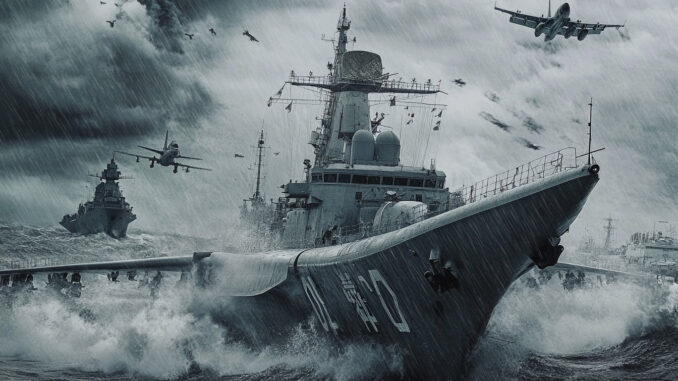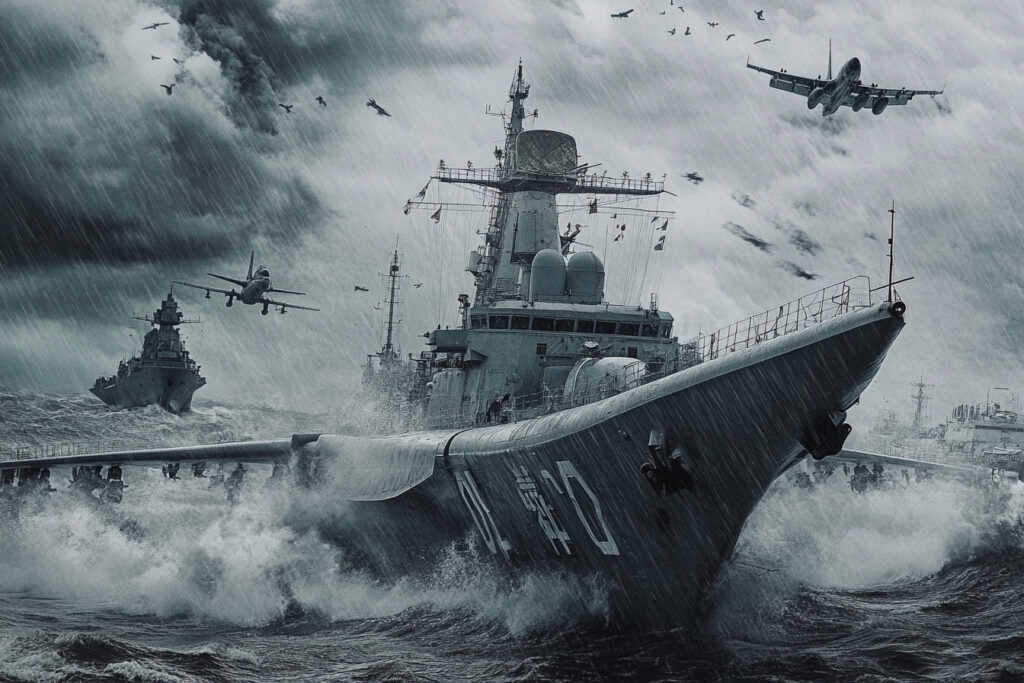
Analysis of the escalation of Chinese military manoeuvres around Taiwan, with 19 military aircraft and 9 ships detected near the island.
Between 5 and 6 September, 19 Chinese military aircraft and 9 Chinese ships were detected around Taiwan, crossing the median line of the Strait on several occasions. This line, not officially recognised by China, serves as a tacit separation between the two territories. Among the aircraft, 15 penetrated the Air Defence Identification Zone (ADIZ) in eastern Taiwan. This type of manoeuvre is part of the grey zone tactics used by Beijing, which aim to increase pressure without resorting to direct force. In response, Taiwan has deployed patrol aircraft, warships and land-based air defence systems. This increase in military activity raises questions about the evolution of tensions in the region.
Increased Chinese air and naval incursions around Taiwan
Between 5 and 6 September, Taiwan’s Ministry of National Defence (MND) monitored the presence of 19 Chinese military aircraft and 9 ships operating in the vicinity of the island. Of these aircraft, 15 crossed the median line of the Taiwan Strait, penetrating the Air Defence Identification Zone (ADIZ) in the east of the island.
The median line of the Taiwan Strait is an unofficial border that has been widely respected by both sides for decades. Although this line is not recognised by Beijing, it has long served as an unspoken mechanism for avoiding military incidents between China and Taiwan. By crossing this line with fighter jets, drones and helicopters, the People’s Republic of China is stepping up its military manoeuvres and sending a clear message of defiance to the Taiwanese authorities.
Taiwan responded by sending in combat air patrols, deploying warships and activating its air defence systems. This type of response has become routine in the face of increasing Chinese military incursions, which seek to wear down Taiwan’s defences and test its capabilities. These military manoeuvres are part of a strategy of gradual tension adopted by China in recent years, aimed at maintaining constant pressure on the island without resorting to direct military action.
Analysis of Beijing’s grey zone tactics
China’s military actions around Taiwan are part of what experts call ‘grey zone tactics’. These tactics are defined by the Center for Strategic and International Studies (CSIS) as ‘efforts to achieve security objectives without resorting to the direct and substantial use of force’. These are calculated manoeuvres which, although provocative, fall short of open armed conflict.
Since September 2020, Beijing has stepped up its use of these tactics, considerably increasing the number of air and naval missions around Taiwan. The aim is to gradually weaken Taiwanese resistance, undermine confidence in its defence capabilities and force a constant response from Taipei. In 2023, Taiwan’s Ministry of Defence reported an average of several incursions per week, involving an increasing number of Chinese ships and aircraft.
These manoeuvres, which include regular overflights of Taiwan’s ADIZ, are aimed at disrupting the daily activities of the island’s armed forces and testing their reactions. The pressure exerted by these repeated incursions is part of a wider strategy to weaken Taiwan’s defences and demonstrate China’s ability to project power in the region. Although these actions do not constitute an open act of war, they do create an atmosphere of permanent tension, which makes an accidental conflict more likely.

Geopolitical and military impacts of the intensification of tensions
The intensification of Chinese military activities around Taiwan has major geopolitical implications, not only for the island but also for the Asia-Pacific region as a whole. For decades, China has claimed Taiwan as an integral part of its territory, and recent actions show that Beijing is prepared to use military means to reassert this claim. In response, Taiwan, backed by allies such as the United States, has strengthened its defensive posture.
This military escalation also increases the risk of an accidental conflict in the region. Each Chinese air or naval incursion forces Taiwan to respond with defensive measures, increasing the possibility of an incident that could rapidly escalate. Furthermore, China’s increased military presence around Taiwan sends a message to foreign powers, notably the United States, that Beijing considers this area to be a red line.
At the same time, these manoeuvres are having an impact on Taiwan’s domestic politics. The Taiwanese people, although familiar with military tensions, are watching this increase in Chinese provocations very closely. The Taiwanese government has stepped up its efforts to strengthen its defence capabilities. In 2022, Taiwan’s defence budget has been increased by 5.3% to 15.2 billion euros, a figure justified by the rising tensions with China.
Consequences for Asia-Pacific regional security
China’s military actions around Taiwan have a direct impact on regional security in the Asia-Pacific region. The region is already the scene of several territorial disputes, notably in the South China Sea, where Beijing claims sovereignty over islands and waters disputed by other countries such as the Philippines, Vietnam and Malaysia. Escalating tensions around Taiwan could increase instability in this strategic region, where billions of euros worth of goods pass through every year.
In response to this situation, countries such as Japan and Australia have stepped up their military cooperation with the United States, which has reaffirmed its commitment to support Taiwan in the event of an attack. In 2021, US forces organised several joint exercises with regional allies, demonstrating their ability to operate in this sensitive area.
The economic impact also needs to be considered. Taiwan is one of the world’s leading producers of semiconductors, an essential component for many technology industries. A major disruption in the region could have a significant impact on the global supply chain, leading to shortages in a range of sectors, from electronics to cars.
China’s growing power in the region is also causing some countries to rethink their defence policies. For example, the traditionally pacifist Japan has announced a significant increase in its military budget for 2022 to meet the challenges posed by China. In addition, the Quad, an informal alliance comprising the United States, Australia, India and Japan, has reasserted itself as a potential counterweight to Beijing’s growing influence in Asia.
Towards uncertain stability
The intensification of Chinese military manoeuvres around Taiwan clearly demonstrates Beijing’s desire to maintain constant pressure on the island. By stepping up its air and naval incursions, China is attempting to wear down Taiwanese forces while sending a strong signal to the international community. While these actions do not yet amount to open warfare, they are no less worrying. They increase the risk of an ‘accidental conflict’, which could have devastating consequences for the region.
The situation also highlights the need for Taiwan and its allies to strengthen their military preparedness and diplomatic coordination in the face of an increasingly assertive China. The challenge now is to prevent these grey zone tactics escalating into direct confrontation, while ensuring regional stability in an area of global strategic importance.
The coming months will be critical in assessing whether tensions will escalate or whether a certain balance can be maintained, thereby guaranteeing peace in one of the world’s most dynamic regions.
War Wings Daily is an independant magazine.